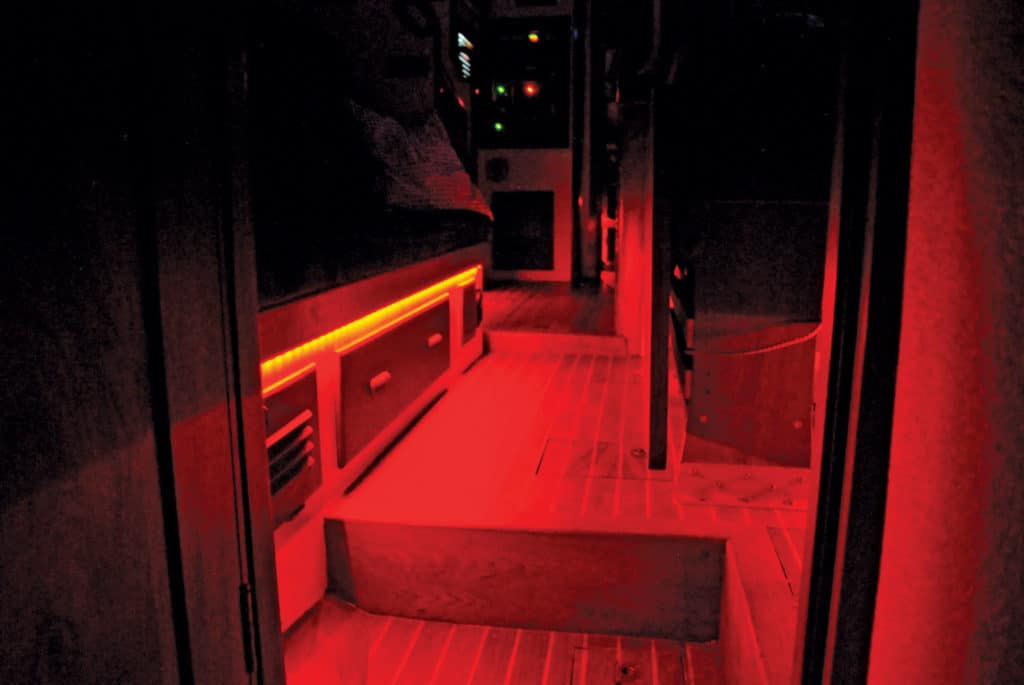
LED Lights
I never thought I’d see the day, much less be the perpetrator. Some of you will think “travesty!”; some will find an element of humor; and some will immediately see the uses for their own boat. Squares need not apply. Close your eyes for a moment and imagine dancing to Adele’s “Rolling in the Deep” with disco-style lights in your boat’s saloon.
If you haven’t heard this song by Adele, you either spend way too much time on your boat or simply don’t ever hear pop music. My kids, ages 4 and 8, are certainly very familiar with it and are now routinely having “dance parties” complete with pink, purple, red and blue flashing lights in the very traditional teak main saloon of Lyra, our Reliance ketch. Sigh.
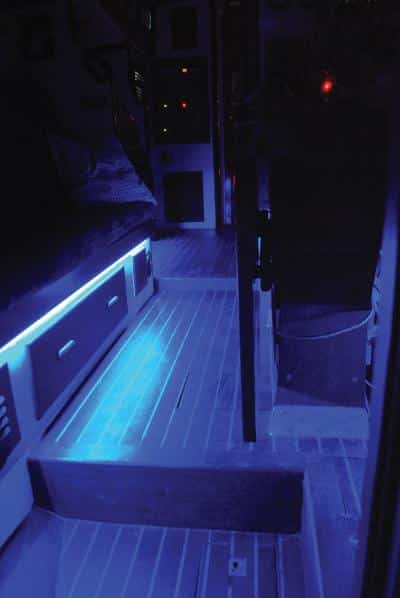
| |LED lights can also come in many other colors just for fun.|
It all started with red lights. The Nautitech 542 catamaran Greenboat 1, on which I spent nearly three weeks crossing the Atlantic, had rope lighting hidden in the cabin roof. I found that the diffuse red lighting it provided was great on night watches. When I found out that it was very inexpensive and more or less weatherproof I decided to put some around our boat as foot lighting. As it turns out, the RGB (red-green-blue) LED light strips are about $40 for 5 meters. They come with a remote and a controller (see “Parts” on the last page of this article). My wife, Jen (an editor at Cruising World) was away at the Strictly Sail Chicago boat show when the supplies I ordered arrived, and the temperature in Rhode Island, where we live aboard year-round, was in the single digits, so the kids were unable to go outside and were climbing the walls. I plugged in the power supply on a lark. Before I knew it, the kids were dancing to Adele and burning off all kinds of energy.
Originally, I only cared about the red light, but with a little more thought, I decided that I would keep the functionality of the remote and the controller, which allows for just about any color you could want, and wire in an override for the red lighting so it can be switched on separately and dimmed with a rheostat.
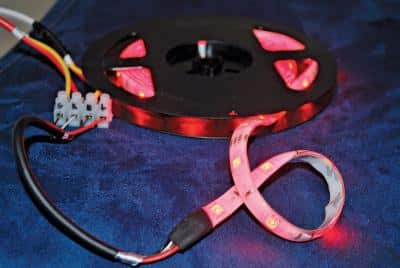
| |These lights come on an easy-to-manage roll.|
I should start by stating that the system I put in is probably overkill. Simply wiring in the supplied controller and running the lights will give all the options, including dimmable red lighting. However, I’m a firm believer in mechanical interfaces for anything electrical aboard our boat, hence the override switch with mechanical dimmers for the red lighting.
If we are going to return to the boat after dark, we leave the lights on a dim red. It’s amazing how much more sure-footed we are when we can see the floor.
Some LED lights can overheat to the point of catching fire if too high a voltage is applied. Be careful to do your research if you choose a different type of lighting strip than what I’ve listed here. Overheating could be a problem if your charging system cranks the voltage up past the 15 volts that I have tested our lights to (on the red setting).
With several passages under the keel now, we can attest that the installation of these lights has improved the safety of Lyra for night sailing. It has also undeniably brought a new level of entertainment to our interior.
Click through for a Step-by-Step Installation Guide.
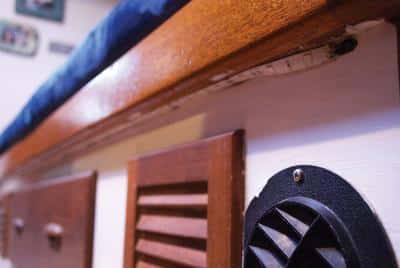
|
**Step-by-Step Installation **
(Estimated 8 hours required)
• Decide where you want the lights. In our case, there’s a small overhang under the saloon settee (1), which hides the lights and gives us glare-free lighting for our feet at night. Make sure that you can get wiring to the selected locations and that there’s room for a terminal block, which you’ll use to neatly connect all the wires, somewhere nearby and out of sight. Note that four small wires will lead from the light strip into the terminal block, one (the white wire) to provide power to the light strip and one for each of the RGB (Red Green Blue) LEDs. You will need six terminations on the main terminal block to accommodate the four light strip wires, plus two connections for the DC power supply, which we’ll get to in a moment.
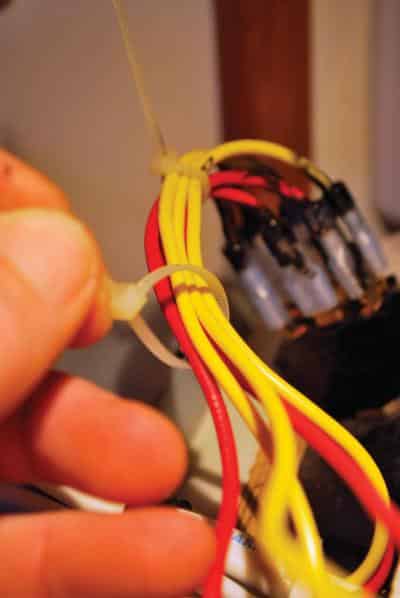
|
• Select a location for the controller, close by the terminal strip if possible. The controller’s sensor is infrared and will need to be accessible to the wireless remote, while the controller may be installed out of sight. Lyra‘s is located under the starboard settee bench, with the sensor caulked with silicone into a small hole through the face of the bench.
• The Size M Coaxial DC Power Plug will replace the supplied AC power supply’s plug on the controller. Using the switched “Controller” red and yellow power leads, connect them to two connectors on the terminal strip. From the strip, run two new lengths of red and yellow wire to the power plug; solder the yellow (-) to the outside tab on the DC plug and the red (+) to the center lead (3). Heat shrink over the connections to protect and immobilize them (4). The AC power supply that came with the controller can now be thrown in your favorite junk drawer — you will not need it again.• Run 5-amp fused positive and negative wires from your cabin-light circuit to the middle poles of your three-position switch. The switch will use this power source to power either the “Red Override” circuit or the “Controller” circuit. The Red Override circuit bypasses the light strip controller and lets you turn on and control just the red LEDs; the Controller circuit powers the controller, which can mix the light and colors of all the LEDs. Now lead the red (+) and yellow (-) wires (two of each color) from the outside poles on the three-position switch (2) down to your terminal block. Mark one set of wires for “Red Override” and the other for “Controller.” I used red and black electrical tape to keep track of each pair.
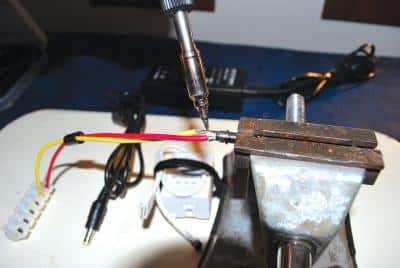
|
• Snip the four-wire controller output leads about 4 inches from the controller. Solder a diode onto the end of the white (+) lead. Connect each of the 4 wires into the terminal strip (5). Note, without the diode, which regulates the direction of current flow in a circuit, current from the Red Override circuit will power up the controller and you will have multicolored dance-party lights instead of muted red lighting when operating in Red Override mode.
• Connect the Red Override wires. The red (+) will go to the white (+) connection on the terminal strip. This is the same connection point that’s used by the white wire with the diode. Connect the yellow (-) lead to the terminal strip connection used by the wire from the controller that’s labeled red “R” wire; that wire controls the red LEDs.
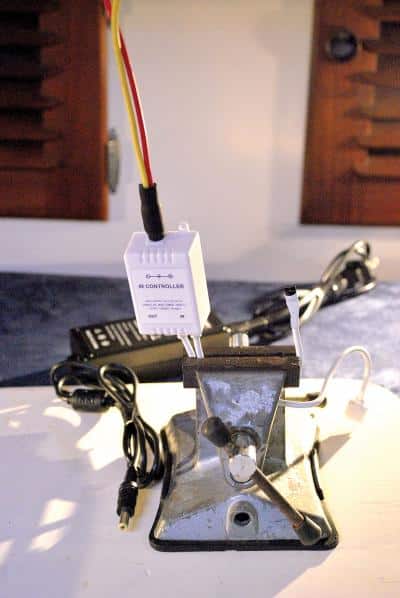
|
• Install and connect the leads from the strip lights at the terminal strip, keeping the color codes as consistent as possible. Some experimentation will be necessary here, since the light strips do not have the same wire colors as our “Red Override” and “Controller” circuits. Labels are helpful.
• Install and wire the dimmer by snipping and connecting it on the Red Override run from the switch to the lights. On Lyra, full-power red lighting pulls 1 amp; dimmed red pulls 0.1 amp.
• Should you wish to break up the light strip to light different areas of the boat, the light strips may be clipped (6) on the copper contacts that occur every 4 inches. Then solder the jumper wires from the terminal strip to the contacts (7) and heat shrink around it (this will keep it from flexing at the solder joint). If you only need the red, only the (+) and R (-) need to be connected.
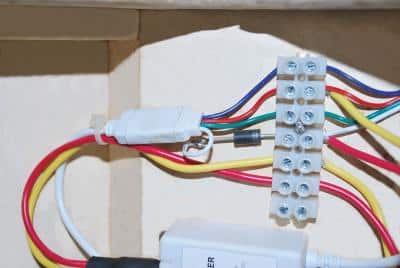
|
Parts
• (1) TaoTronics TT-SL001 Waterproof 16.4 Ft RGB Color Changing Kit with LED Flexible Strip
Source: Amazon.com
Cost: $29.99 shipped
• 100 feet of 18-gauge Ancor safety wire (ABYC minimum recommended size for wire runs)
Source: Local marine store
Cost: $40
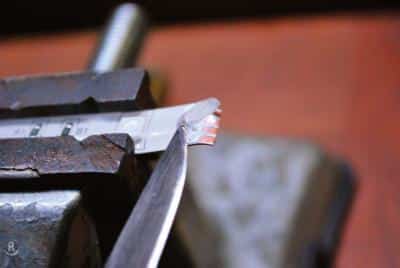
|
• (3) 12-Position European-Style Mini Terminal Strips
Source: Radio Shack
Cost: $11.20
• (1) Size M Coaxial DC Power Plug (2-Pack)
Source: Radio Shack
Cost: $3.49
• (1 pack) 3-Amp Barrel Diodes
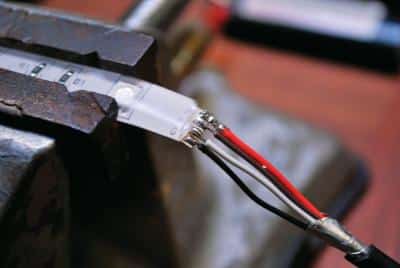
|
Source: Radio Shack
Cost: $1.99
• Marine-grade DPDT switch, on/off/on positions, 6 blade terminals
Source: Local marine store
Cost: $19.99
• (2) LED wholesalers PWM Dimming Controller for LED Lights or Ribbon, 12 Volt 8 Amp, 3301
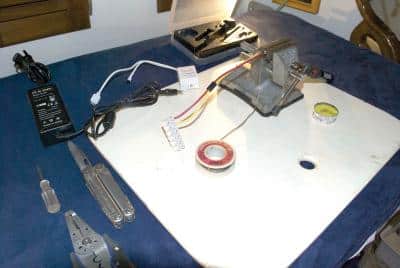
|
Source: Amazon.com
Cost: $15.66
• Assorted spade connectors, solder, wire ties and heat shrink
Source: Local marine store
Cost: $20
• Total cost: $142.32
Web Extra
Download the wiring diagram for this project.
This article first appeared in the February 2014 issue of Cruising World.








